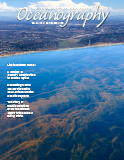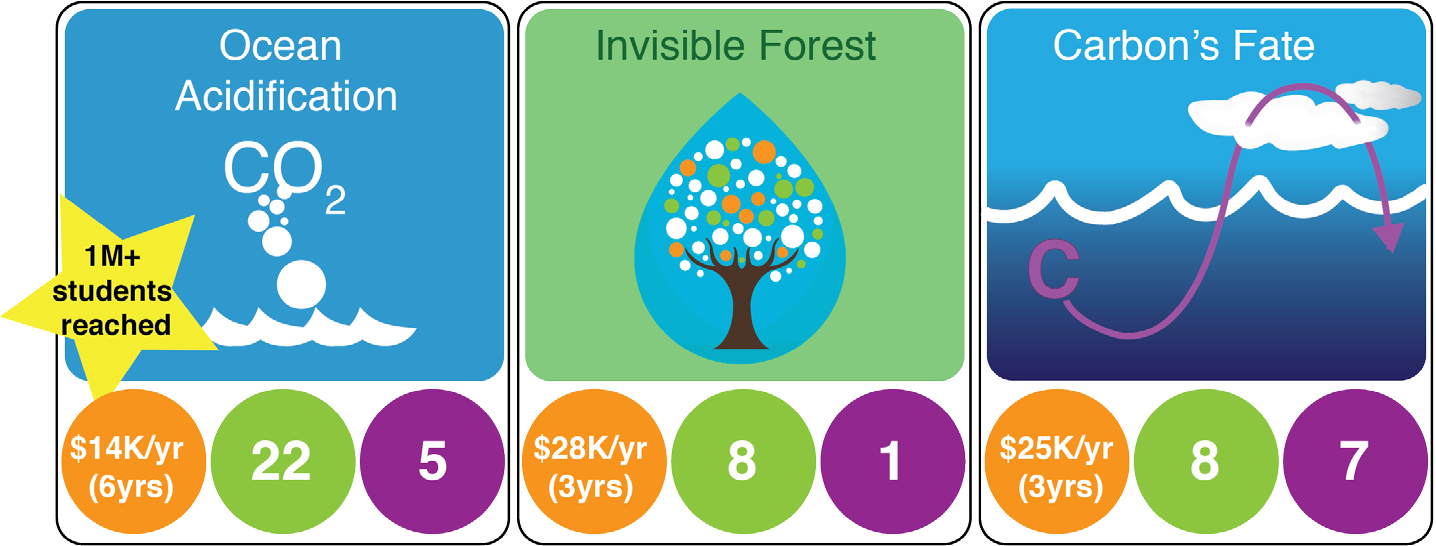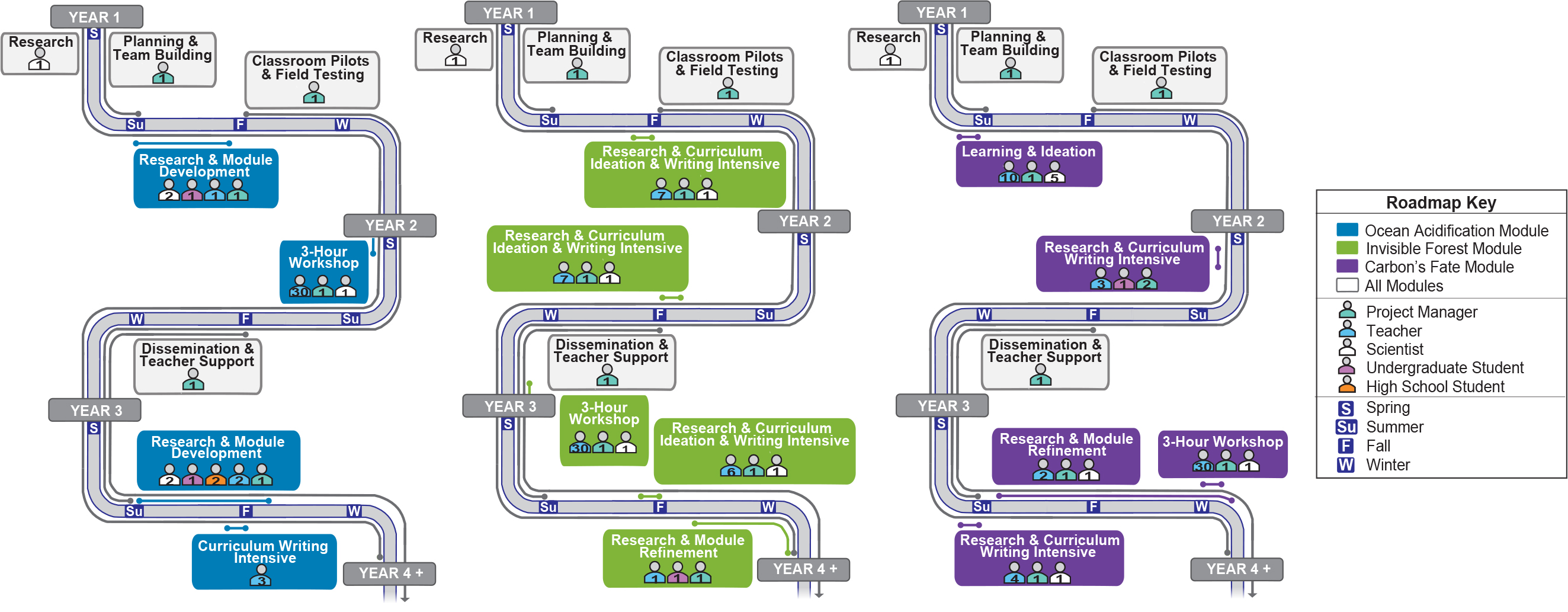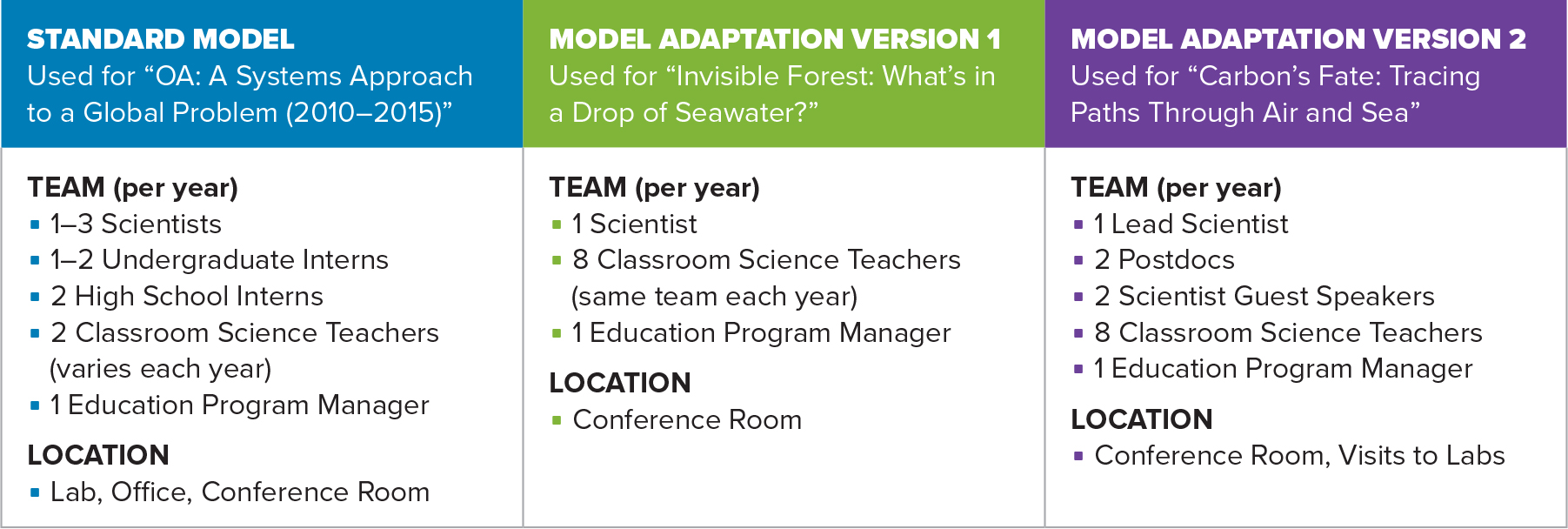Full Text
We describe a framework for incorporating cross-disciplinary oceanographic research into high school curriculum modules and discuss how this framework could be adopted broadly by ocean scientists to build cohesive broader impacts programs nested within individual oceanographic research programs. The framework has brought ocean science to over one million students in the form of “curriculum modules,” one of which has been adopted as an official high school curriculum by the California State Board of Education. The framework for developing these curricular modules is easy to replicate and could help to scale up education and outreach efforts to advance ocean science in classrooms.
The US National Science Foundation (NSF) requires grant-funded research to include broader impacts activities. According to NSF’s Proposal and Award Policies and Procedures Guide, broader impacts activities should “benefit society and contribute to the achievement of specific, desired societal outcomes” while connecting to the funded research. NSF expects broader impacts activities to be inclusive of underrepresented groups in science, technology, engineering, and mathematics (STEM). While scientists acknowledge the significance of integrating outreach into their research programs, there are few models for achieving sustained, long-term, scalable impacts for underrepresented groups. The goal of this commentary is to empower our colleagues to broadly disseminate their research to K–12 school systems.
Program Framework
At the outset of the project, we reviewed and considered many techniques and programs for translating ocean research for high school classrooms. There are hundreds of excellent stand-alone activities available online, but few are cohesive interdisciplinary modules that integrate content, practices, and skills within a theme. Curriculum modules can provide useful tools for students and teachers to gain content knowledge and research skills (NRC, 2005; Bybee and Van Scotter, 2007; Shein and Tsai, 2015; McLaughlin et al., 2016). While fewer modules include artists in partnerships for developing curriculum modules, there is evidence that integrating art and science sparks and sustains innovation (Wilson, 1999; Maeda, 2013; Featherstone, 2016).
Recognizing the need for ocean scientists to fulfill the broader impacts requirements of their funding, we designed the Systems Education Experiences (SEE) curriculum development framework (https://see.isbscience.org). Developed by the Institute for Systems Biology (ISB) in author Baliga’s laboratory, the SEE model works well with systems biology research and scientist-teacher-student programs in a relatively small research institute (~200 staff working across 12 lab groups). The program brings together students, teachers, and scientists to conduct collaborative research and then translate that research into classroom-ready modules that cross disciplines. The four-part, iterative curriculum development framework is centered on summer internships for high school students and teachers (https://see.isbscience.org). The four curriculum development components are: (1) scientific research leading to module ideation and the development of cohesive standards-based activities, (2) classroom pilots, (3) module refinement and optimization of online resources (e.g., lesson plans, teaching aids), and (4) dissemination and support through teacher training. The result is an engaging, phenomenon-based curriculum module that builds skills in solving a specific real-world problem and that addresses contemporary education standards.
Using this framework, we created two STEM and one STEAM (science, technology, engineering, art, and mathematics) curriculum modules for high school students based on the oceanographic research programs of authors Orellana and Thompson (Figure 1). We used the standard model described above for developing the “Ocean Acidification: A Systems Approach to a Global Problem” module (Ludwig et al., 2015), which has been adopted by the State of California Board of Education and integrated into the state’s recommended three-course framework. When we developed “Invisible Forest: What’s in a Drop of Seawater?,” we adapted the standard model to enable working across multiple institutions in different cities. Similarly, when we developed “Carbon’s Fate: Tracing Paths through Air and Sea,” the standard curriculum development model required minor adjustments to accommodate cruise schedules and provide access to lab facilities for high school students. Regardless of the adaptations, the curriculum module’s end product and aims were achieved. Figure 2 and Table 1 summarize how the standard program model was adapted for each module.
|
|
By bringing research, data, and exploration to high school teachers and students, these modules teach the scientific process and help students develop higher-level thinking skills that are used in systems research. The subject matter and pedagogy of the modules align with the Next Generation Science Standards (NGSS, 2013) and 21st Century Learning (P21, 2019). The NGSS encourage students to learn science by doing what scientists do, moving from content-driven instruction to integrated learning in which students immerse themselves in the practice of science.
The modules are distributed online (https://see.isbscience.org/modules/) and through workshops and courses.
|
|
|
|
Ocean-Centered SEE Modules
Ocean Acidification: A Systems Approach to a Global Problem
Students begin this two- to five-week module by critically assessing news articles on ocean acidification. Working together, they combine their findings into a network that identifies the key players in this global phenomenon. They then use their network to plan experiments and use inquiry to understand the effects and properties of CO2. Next, the students design a second systems-level experiment or subsystem based on chosen stakeholders to explore how a change in CO2 impacts their subsystem. Students model collaborative research by designing and completing cohesive sets of experiments that build off others’ experiments. In addition to gathering their own data, student participants use real-time regional and worldwide ocean and genetic data to predict the response to further disruptions. In the culminating activity, students role play as delegates to an international summit; make recommendations for scientists, politicians, and people globally; and reflect on how they might positively impact their system. Funds for this module averaged $14,000 per year for six years, about 7% of the grant’s total budget (Figure 1).
Invisible Forest: What’s in a Drop of Seawater?
This oceanographic STEAM module provides a look at the very small and the very large aspects of phytoplankton, leading to a deeper understanding of energy, oxygen, biological scales, and the ocean system. The module begins with the discovery of the tiniest phytoplankton in the ocean by 2019 Crafoord prize winner Sallie “Penny” Chisholm. The module then moves to practice processing real oceanographic data from stations that collect time series such as Station ALOHA in the Pacific Ocean. Students consider whether humans could survive in a world without land plants by learning about the photosynthetic microbes teeming within every drop of seawater. At the end of the module, students use artistic skills to illustrate how the cells in a drop of seawater support human life and the global Earth system. Throughout this phenomenon-based three-dimensional unit, a project-based-learning component guides students as they explore microbial life in a drop of seawater. Students design and evaluate questions to investigate phytoplankton phenomena. All the components of STEAM are blended here, giving students opportunities to express their learned knowledge through many means. Funds for the project averaged $28,000 per year (about 10% of the total grant), with 25% of those funds leveraged from other sources (Figure 1).
Carbon’s Fate: Tracing Paths Through Air and Sea
In this module, students explore physical and chemical ocean conditions through experimentation and computational models to learn how microbes drive the ocean carbon cycle. They learn that carbon and oxygen remain in equilibrium in the ocean carbon cycle as the seas inhale and exhale to maintain Earth’s biosphere, hydrosphere, atmosphere, and geosphere, unless conditions change. Students learn how scientists monitor the ocean, like doctors taking the vital signs of a patient, which helps them see changes occurring worldwide. They explore how the changing atmosphere, melting glaciers, and the actions of individuals affect the global carbon balance. Following in the footsteps of climate and ocean scientists, students explore carbon’s fate by observing patterns of carbon distribution in large data sets collected and visualized through Ocean Data View (ODV) software (https://odv.awi.de). The module concludes with student proposals for an invention or intervention to answer the question “What can you do?” Through this final activity, high school students evaluate the carbon system’s impact and share its importance. Funds for the project averaged $25,000 per year (8.6% of the total grant) (Figure 1).
Lessons Learned: Feasible Solutions to Enable Success
1. Leveraging Funding Allows Program Continuity and Sustained Impact
Funding is perhaps the first challenge in bringing together a team to develop curricula. The architecture of our program requires funding for participant support during curriculum development as well as sustained funding to maintain distribution platforms in the years following curriculum launch. Primary funding for the modules was obtained through NSF Ocean Sciences Division awards, which provided salary support for researchers (PI and Co-PIs), the manager, and hourly participant support for teachers and students (Figure 1). Next, we found that leveraging one or two other grants enabled more robust and in-depth lessons, instructional aids, and dissemination. Leveraging other grants also permits a reinforcing cycle for projects, which is crucial for sustainable programming. While one project is nearing completion, another project is kicking off. Teacher groups can be brought together to advise on and learn about new products. As researchers seek continuity among distinct research projects for efficient use of funds across sources, it is possible to attain similar continuity among broader impacts efforts.
Taking advantage of existing strategic partnerships has also been a vital aspect of the funding for the modules. These partnerships are especially helpful in furthering the dissemination of curriculum modules. The oceanographic community is particularly adept at networking to share one another’s education-related products with their audiences. There are many opportunities to do so through conferences, meetings, and online platforms. By leveraging other institutional funds and building new partnerships, we coordinated all activities and provided better support for teachers before, during, and after the dissemination process. Furthermore, leveraging funds and partnerships allowed us to reach out to more rural schools and develop more supportive interactions with student populations who are underrepresented in STEM or historically marginalized. We could also support diverse students and teachers through a wider variety of professional development.
2. Achieve Success Through Sustained Dissemination
Implementing a plan for sustained dissemination of curriculum is key to the success of the modules. The dissemination goal includes building ocean awareness among the maximum number of students, reaching students underrepresented in STEM, and updating the modules based on teacher feedback and new scientific findings. Our dissemination efforts focus on reaching teachers and education professionals. To reach audiences of teachers, we presented at education conferences (e.g., National Science Teaching Association) and scientific conferences (ASLO, Ocean Sciences Meeting) in sessions devoted to outreach and education. A robust curriculum website, a strong social media presence, and articulated, accessible frameworks allow for broad implementation in schools across entire states. Using collaborative software such as Google Drive, Google Meet, Dropbox, Zoom, and Skype allows multiple team members to quickly adapt and create usable curricular and training products. The use of online collaborative resources also minimizes issues with managing numerous document versions and maximizes the ability to update and disseminate new versions in response to field test data. Finally, linking closely to mandated standards, particularly Next Generation Science Standards (NGSS, 2013), Common Core (http://www.corestandards.org), and 21st Century Learning (P21, 2019), appeals to teachers who seek new resources and increases use of curriculum and participation in professional development.
3. Define Roles to Make Teams Productive
Assembly of functional teams of people from diverse career paths and disciplinary backgrounds is essential in order to work productively toward the development and dissemination of the educational modules. Our experience reveals several challenges, including competition between the researchers and teachers on disciplinary expertise, barriers in communication across disciplines (e.g., physics and biology), resolving differences in opinion, and time management. To address these challenges, we suggest defining the following team roles. The researcher’s role is to provide information on the state of knowledge of the field, as well as discoveries and unknowns (i.e., research questions) that motivate ongoing research. This transfer of knowledge takes the form of presentations and conversations throughout module development. As experts in their fields, the teachers identify aspects of the researcher’s project that link to education standards and/or challenge current curricula or understanding. They lead the work in defining the educational module’s scope and deciding which of the many linked concepts in the researcher’s work should be translated to students. Another vital role for teachers is as experts in student motivation. Based on years of classroom experience, teachers can identify “hooks” and “storylines” to engage students and indicate what types of activities work, or do not work, in a classroom setting.
We recommend having an education program manager who is a regular part of the curriculum development process. The program manager’s role includes recruiting participants and getting to know them in order to form appropriate teams to facilitate the work. The program manager mediates differences of opinion, ensures work moves along with a tight schedule, and takes care of the many logistics for assembling a new team. For instance, participants should have ownership of the process, the place, and the product. Accomplishing this feeling of ownership requires setting up a suitable workspace for the participants, ensuring they feel welcome in that space, and securing access to needed resources, including being promptly paid for their participation. Our standard program model provides this for all participants—students, teachers, and in some cases, artists. In the modified model used with “Invisible Forest and Carbon’s Fate,” participants primarily included teachers. Undergraduate and high school student involvement requires extra care to ensure their safety. Providing paid internships to high school participants requires a minor’s work permit and closer oversight. Because of this, the program managers involved in our process are always certified teachers who are well versed in the needs and norms of working with high school students, especially those from diverse backgrounds, and other teachers.
4. Networking and Strategic Partnerships Support Module Development
Establishment of strategic partnerships, critical to developing and disseminating the modules, can be achieved through networking and garnering new funding sources to fuel new efforts and/or broaden the impact of existing initiatives. Also, strategic partnerships allow the project leader to stay current with what is being generated and offered, which is key to making certain the curriculum module is filling a need that exists. For instance, the ocean acidification module was conceived of and built when ocean acidification research was relatively new in the field oceanography. We worked closely with many partners (NOAA, Sea Grant, the University of Hawai‘i Center for Microbial Oceanography: Research and Education, California Academy of Sciences, the Northwest Association of Networked Ocean Observing Systems, Stanford University) to ensure we were all developing products that complemented each other’s efforts.
Conclusions and Future Directions
To date, SEE has disseminated eight curriculum modules across 50 states and multiple countries with an estimated use by over 2.5 million students. Teachers (52), students (142), and researchers (35) collaboratively created 12 modules. SEE has directly trained 3,000+ teachers and 460 diverse high school students (for 120–320 hours each). Over 60,000 additional teachers have received introductory training (15–180 minutes). Findings from evaluations of SEE projects show that students gain valuable skills and knowledge by working closely with professional scientists and artists. This collaborative process also provides professional development for teachers and scientists (https://see.isbscience.org/testimonials/).
SEE itself and the three ocean science curriculum modules discussed here were made possible through the broader impacts components of NSF awards. We used 8%–20% of several NSF awards for the inception, development, and scale-up of SEE to bring current science concepts and practices to secondary students and teachers. These funds enable participant support and field testing and cover the SEE education manager’s time for coordination and participant management and travel for dissemination (Figure 1).
We have reached over one million high school students with our three ocean-centered curriculum modules. We attribute our success to using strategic partnerships and to the continuity ensured by grant-to-grant efforts for maintaining our program over many years. We hope this program will be an effective model for others to create high impact, inclusive, and cohesive broader impacts programs within their oceanographic research activities. We emphasize the critical role of teachers in these endeavors, as they are experts in their fields and can act as conduits between researchers and the public via the education of high school students. The module-based framework is effective at broadening participation on a much bigger scale than one-time outreach events. Our future work with this framework will focus on improving links between individual modules, providing teachers with curricula that span disciplines and grade levels, and helping others build similar programs. Furthermore, we are developing distance-learning versions of these modules to engage even more students from diverse backgrounds in ocean science.




